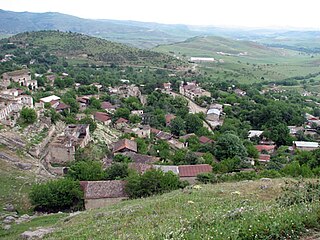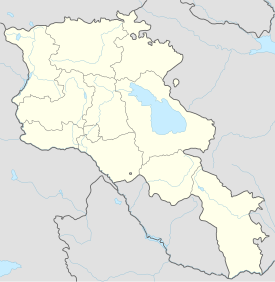
Yerevan is the capital and largest city of Armenia, as well as one of the world's oldest continuously inhabited cities. Situated along the Hrazdan River, Yerevan is the administrative, cultural, and industrial center of the country, as its primate city. It has been the capital since 1918, the fourteenth in the history of Armenia and the seventh located in or around the Ararat Plain. The city also serves as the seat of the Araratian Pontifical Diocese, which is the largest diocese of the Armenian Apostolic Church and one of the oldest dioceses in the world.

The Armenian Apostolic Church is the national church of Armenia. Part of Oriental Orthodoxy, it is one of the most ancient Christian institutions. The Kingdom of Armenia was the first state in history to adopt Christianity as its official religion under the rule of King Tiridates III, of the Arsacid dynasty in the early 4th century.

Stepanakert or Khankendi is a city in the Nagorno-Karabakh region of Azerbaijan. The city was under the control and the capital city of the breakaway Republic of Artsakh prior to the 2023 Azerbaijani offensive in the region. The city is located in a valley on the eastern slopes of the Karabakh mountain range, on the left bank of the Qarqarçay (Karkar) river.

A khachkar or Armenian cross-stone is a carved, memorial stele bearing a cross, and often with additional motifs such as rosettes, interlaces, and botanical motifs. Khachkars are characteristic of medieval Christian Armenian art.

Gyumri is an urban municipal community and the second-largest city in Armenia, serving as the administrative center of Shirak Province in the northwestern part of the country. By the end of the 19th century, when the city was known as Alexandropol, it became the largest city of Russian-ruled Eastern Armenia with a population above that of Yerevan. The city became renowned as a cultural hub, while also carrying significance as a major center of Russian troops during Russo-Turkish wars of the 19th century.

Armenia, officially the Republic of Armenia, is a landlocked country in the Armenian Highlands of West Asia. It is a part of the Caucasus region and is bordered by Turkey to the west, Georgia to the north and Azerbaijan to the east, and Iran and the Azerbaijani exclave of Nakhchivan to the south. Yerevan is the capital, largest city and financial center.

Parakar, formerly Shirabad, is a village in the Parakar Municipality of the Armavir Province of Armenia. According to the 2010 official estimate, the population of Parakar is 9,297. The village is notable for its gypsum mine. The Zvartnots International Airport is located just to the south of the village.

Alvank ; is a village in the Meghri Municipality of the Syunik Province in Armenia.
Arpunk is a village in the Vardenis Municipality of the Gegharkunik Province of Armenia. Three kilometers southeast of the village is a 15th-century church. The village was populated by Azerbaijanis before the exodus of Azerbaijanis from Armenia after the outbreak of the Nagorno-Karabakh conflict. In 1988-1989 Armenian refugees from Azerbaijan settled in the village.
Azat (Armenian: Ազատ is a village in the Vardenis Municipality of the Gegharkunik Province of Armenia. In 1988-1989 Armenian refugees from Azerbaijan settled in the village.

Davit Bek is a village in the Kapan Municipality of the Syunik Province in Armenia. Located in the Kashun river valley, 28 kilometers from the regional center of Kapan, it lies 1150 meters above sea level. It is named after the Armenian patriotic leader David Bek.
Karmrashen is a village in the Vayk Municipality of the Vayots Dzor Province of Armenia.
Musayelyan is a village in the Ashotsk Municipality of the Shirak Province of Armenia. The St. Trdat church built in 1896 is located in the village.

Pokr Masrik is a village in the Vardenis Municipality of the Gegharkunik Province of Armenia. Azerbaijanis lived in the village prior to their exodus from Armenia after the outbreak of the Nagorno-Karabakh conflict. From 1988 and onward, Armenian refugees from Azerbaijan settled in the village. The village is located close to Mets Masrik.
Shatvan is a village in the Gegharkunik Province of Armenia. Khachkars and church ruins have been preserved in the village.

Sotk is a village in the Vardenis Municipality of the Gegharkunik Province of Armenia, well known for its gold mines.

Yeghegis is a village in the Yeghegis Municipality of the Vayots Dzor Province in Armenia. It has a rich historical past, with the medieval Zorats Church, the Tsakhats Kar Monastery and the Smbataberd fortress being located in the vicinity of Yeghegis, as well as a Jewish cemetery from the 13th century.

Vagharshapat is the 5th-largest city in Armenia and the most populous municipal community of Armavir Province, located about 18 km (11 mi) west of the capital Yerevan, and 10 km (6 mi) north of the closed Turkish-Armenian border. It is commonly known as Ejmiatsin, which was its official name between 1945 and 1995. It is still commonly used colloquially and in official bureaucracy, a case of dual naming.
Hoçaz or Hochants is a village in the Lachin District of Azerbaijan.

Tugh or Togh is a village in the Khojavend District of Azerbaijan, in the region of Nagorno-Karabakh. The village had a mixed Armenian-Azerbaijani population before the First Nagorno-Karabakh War, the Azerbaijani inhabitants fled the fighting in 1991, and the Armenian population fled the village during the 2020 Nagorno-Karabakh war.






















